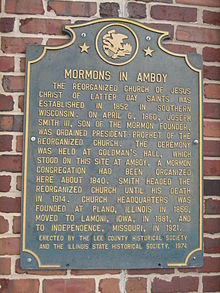
The Community of Christ, known from 1872 to 2001 as the Reorganized Church of Jesus Christ of Latter Day Saints (RLDS), is an American-based international church, and is the second-largest denomination in the Latter Day Saint movement. The church reports 250,000 members in 1,100 congregations in 59 countries. The church traces its origins to Joseph Smith's establishment of the Church of Christ on April 6, 1830. His eldest son Joseph Smith III formally accepted leadership of the church on April 6, 1860 in the aftermath of the 1844 death of Joseph Smith.
Among many churches in the Latter Day Saint movement, the First Presidency is the highest presiding or governing body. Present-day denominations of the movement led by a First Presidency include the Church of Jesus Christ of Latter-day Saints, the Community of Christ, Remnant Church of Jesus Christ of Latter Day Saints, and the Righteous Branch of the Church of Jesus Christ of Latter-Day Saints.
In the Latter Day Saint movement, the President of the Church is generally considered to be the highest office of the church. It was the office held by Joseph Smith, founder of the movement, and the office assumed by many of Smith's claimed successors, such as Brigham Young, Joseph Smith III, Sidney Rigdon, and James Strang. Several other titles have been associated with this office, including First Elder of the church, Presiding High Priest, President of the High Priesthood, Trustee-in-Trust for the church, Prophet, Seer, Revelator, and Translator. Joseph Smith was known by all of these titles in his lifetime.

The Latter Day Saint movement is the collection of independent church groups that trace their origins to a Christian Restorationist movement founded by Joseph Smith in the late 1820s.

The Latter Day Saint movement is a religious movement within Christianity that arose during the Second Great Awakening in the early 19th century and that led to the set of doctrines, practices, and cultures called Mormonism, and to the existence of numerous Latter Day Saint churches. Its history is characterized by intense controversy and persecution in reaction to some of the movement's doctrines and practices and their relationship to mainstream Christianity. The purpose of this article is to give an overview of the different groups, beliefs, and denominations that began with the influence of Joseph Smith.
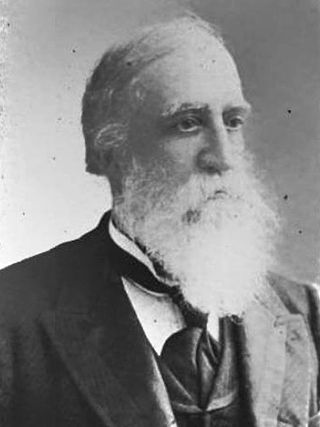
Joseph Smith III was the eldest surviving son of Joseph Smith and Emma Hale Smith. Joseph Smith III was the Prophet-President of what became the Reorganized Church of Jesus Christ of Latter Day Saints, renamed Community of Christ in 2001, which considers itself a continuation of the church established by Smith's father in 1830. For fifty-four years until his own death, Smith presided over the church. Smith's moderate ideas and nature set much of the tone for the church's development, earning him the sobriquet of "the pragmatic prophet".

William Marks was a leader in the early days of the Latter Day Saint movement and was a member of the First Presidency in the Reorganized Church of Jesus Christ of Latter Day Saints. Marks is mentioned in the Doctrine and Covenants in sections 117 and 124 of the Church of Jesus Christ of Latter-day Saints edition and in section 115 of the Community of Christ edition.
Lineal succession was a doctrine of the Latter Day Saint movement, whereby certain key church positions were held by right of lineal inheritance. Though lineal succession is now largely abandoned, the offices connected with the practice were the President of the Church and the Presiding Patriarch.

Israel Alexander Smith was the fourth son of Joseph Smith III and a grandson of Joseph Smith Jr., the founder of the Latter Day Saint movement. Israel A. Smith succeeded his brother, Frederick M. Smith, as Prophet-President of the Reorganized Church of Jesus Christ of Latter Day Saints on April 9, 1946.
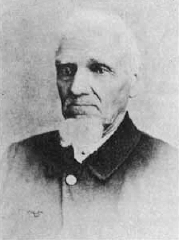
William Smith was a leader in the Latter Day Saint movement and one of the original members of the Quorum of the Twelve Apostles. Smith was the eighth child of Joseph Smith Sr. and Lucy Mack Smith and was a younger brother of Joseph Smith Jr., the founder of the Latter Day Saint movement.
The succession crisis in the Latter Day Saint movement occurred after the murder of Joseph Smith, the movement's founder, on June 27, 1844.

Jason William Briggs was a leader in the early history of the Latter Day Saint movement and was instrumental in bringing about the 1860 "Reorganization" of the church, which resulted in the establishment of the Reorganized Church of Jesus Christ of Latter Day Saints.
A Rigdonite is a member of the Latter Day Saint movement who accepts Sidney Rigdon as the successor in the church presidency to the movement's founder, Joseph Smith Jr. The early history of the Rigdonite movement is shared with the history of the Latter Day Saint movement, but as of the 1844 succession crisis becomes distinct. Sidney Rigdon and other church leaders, including Brigham Young and James J. Strang, presented themselves as leaders of the movement and established rival church organizations. Rigdon's group was initially headquartered in Pittsburgh, Pennsylvania. It was known at one point as the Church of Jesus Christ of the Children of Zion, and its adherents are referred to as Rigdonites, or sometimes "Pennsylvania Latter Day Saints" or "Pennsylvania Mormons." The only surviving organization that traces its succession back to Rigdon's organizations is The Church of Jesus Christ, founded by a group of Rigdon's followers led by William Bickerton.
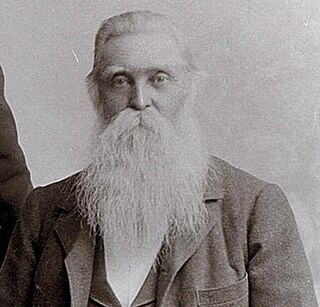
John Smith, was the fifth Presiding Patriarch of the Church of Jesus Christ of Latter-day Saints. His father was Hyrum Smith, the older brother of Joseph Smith, the founder of Mormonism. Having served for 56 years, he was the longest serving Presiding Patriarch in the history of the LDS Church. Smith traveled west to Winter Quarters and then Salt Lake City with the Mormon pioneers. He traveled with Heber C. Kimball's party and his step-mother Mary Fielding Smith. Smith joined the "Battalion of Life Guards" to protect the Latter-day Saints from Native Americans.
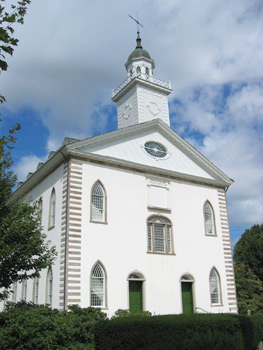
The history of Community of Christ, formerly known as the Reorganized Church of Jesus Christ of Latter Day Saints, covers a period of approximately 200 years. The church's early history traces to the "grove experience" of Joseph Smith, who prayed in the woods near his home in Palmyra, New York, in the early-19th century. Several accounts of this experience have surfaced over the years. Most of the accounts share a common narrative indicating that when he went to the woods to pray, he experienced a period of encountering evil or despair, but then experienced an epiphany or vision in which he came to know and understand God's goodness. Later, as an adult, Smith founded the Church of Christ on April 6, 1830.
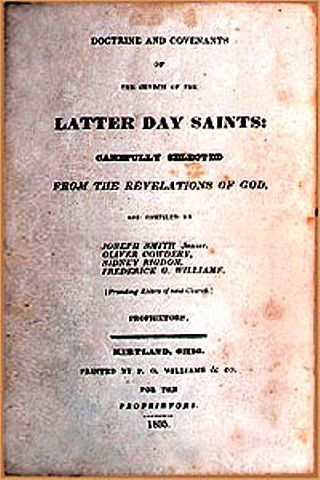
The One Mighty and Strong is the subject of an 1832 prophecy by Joseph Smith, the founder of the Latter Day Saint movement. The prophecy echoes and parallels the words and prophecies contained in Isaiah 28:2 and Isaiah 11:11; 2 Nephi 3:21-25. The One Mighty and Strong was said by Smith to be one who would "set in order the house of God" and arrange for the "inheritances of the [Latter Day] Saints." Since the prophecy was proclaimed, many Latter Day Saints have claimed to be or to have otherwise identified the One Mighty and Strong. Some schismatic Latter Day Saint sects have arisen as a result of such claims.
The Church of Jesus Christ (Bickertonite) is part of the Latter Day Saint movement. When Joseph Smith, the founder of the movement, died there was a dispute regarding who should lead the church as his successor. The Quorum of the Twelve, led by Brigham Young, argued that they should have the right to lead the church while one of the church leaders, Sidney Rigdon, argued that he should act as protector of the church until a permanent leader was chosen. Those who followed Rigdon formed the "Church of Christ" with its center being Pittsburgh, Pennsylvania. After an attempt to start a communitarian society, Church of Christ broke apart by 1847. William Bickerton associated himself for two years with the Church of Jesus Christ of Latter-day Saints and later left them behind refusing to accept some of their beliefs, including polygamy. In the 1850s Bickerton's preaching led to the formation of a new church in Eastern Pennsylvania. Over the following years Bickerton's church faced two schisms related to doctrinal issues. Its current official name, The Church of Jesus Christ, was adopted by 1941.

Elbert Aoriul Smith was an American leader in the Reorganized Church of Jesus Christ of Latter Day Saints. He was a member of the church's First Presidency from 1909 to 1938 and the Presiding Patriarch of the church from 1938 to 1958.

Austin Cowles was a leader and hymnwriter of the early Latter Day Saint movement. Over the course of his life, Cowles, an ardent anti-polygamist, was affiliated with Joseph Smith's Church of Christ, William Law's True Church of Jesus Christ of Latter Day Saints, Sidney Rigdon's Church of Christ, James Strang's Church of Jesus Christ of Latter Day Saints, James C. Brewster's Church of Christ, and Joseph Smith III's Reorganized Church of Jesus Christ of Latter Day Saints.
